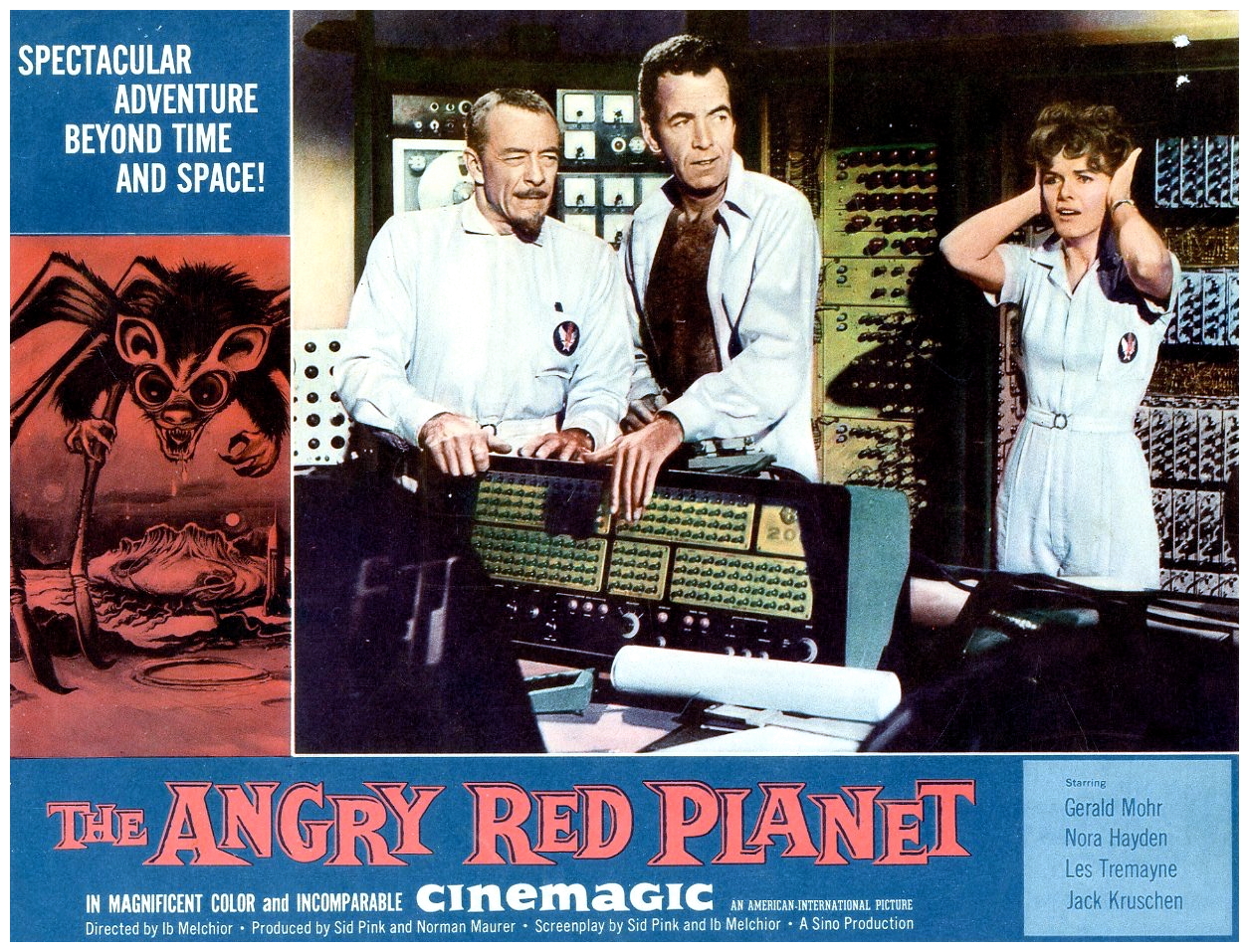
SYNOPSIS:
“Our first manned flight to Mars returns after being thought lost in space. Only two survivors of the original four are on board, Colonel Thomas O’Bannion and Doctor Iris Ryan. O’Bannion has a green growth on his arm, and nothing that the doctors do will kill it. Ryan, under hypnosis, tells of their adventures on Mars. Thought to be a dead planet, it’s inhabited with man-eating plants, giant bat-rat-spider-crab monsters, a strange city on a lake, and a one-eyed monster that dissolves anything that it swallows or touches.” (courtesy IMDB)
REVIEW:
Born in Denmark in 1917, Ib Melchior lived a rather amazing life before passing away last year in 2015. Highly decorated during World War II (supplying evidence that led to the Nuremburg trials), he went on to become an award-winning documentarian, author, filmmaker, screenwriter and playwright. Novels include Hitler’s Werewolves (1972), The Tombstone Cipher (1983) and Code Name Grand Guignol (1987). Stage productions include Hour Of Vengeance (1982) based on the ancient Viking tale of Amled, which was ripped off…I mean, the original inspiration for William Shakespeare‘s Hamlet. Teleplays include The Outer Limits episode The Premonition (1965), and his most high-profile film credit was as co-writer of Robinson Crusoe On Mars (1964). He also wrote screenplays for Reptilicus (1961), Journey To The Seventh Planet (1962) and the English language version of Planet Of The Vampires (1965).

Sadly, Melchior directed only two movies in his lifetime: The Time Travellers (1964) and The Angry Red Planet (1959). Hollywood producer Sidney Pink had a treatment entitled The Planet Mars about an expedition to the red world. Pink and Melchior met at a party, and Melchior agreed to write the screenplay only if he was also allowed to direct. Then Pink met film technician Norman Maurer, who was developing a new cinematic technique called CineMagic which was supposed to make paintings look like photographs. It soon became obvious all was not going to plan: “The damn CineMagic didn’t work like it should, it was supposed to be sort of a 3-D effect. What we came up with was great anyway.” Melchior completed the screenplay in August of 1959 and, armed with a US$200,000 budget and a nine-day schedule, began shooting a month later.

The story is largely told in flashback, and begins as spaceship MR-1 returns to Earth after the first manned flight to Mars. Thought to have been lost in space, the ship reappears but mission control are unable to make radio contact, so they land the ship successfully by remote control. Two survivors are found: Doctor Iris Ryan (Naura Hayden) and Colonel Tom O’Bannion (Gerald Mohr), but the colonel’s arm covered by a strange alien growth. Ryan eventually regains consciousness and attempts to recall their journey to the red planet. While exploring Mars, Ryan is attacked by a carnivorous plant and saved by Chief Warrant Officer Sam Jacobs (Jack Kruschen) who shoots the plant with a freeze ray. They also encounter a gigantic bat-rat-spider creature, at first mistaking its legs for trees, and the monster is repelled by Jacobs again with his trusty ray gun. When they return to their ship, the crew find their radio jammed and the MR-1 is unable to take-off due to a forcefield of some kind.

O’Bannion leads the crew to a Martian lake with a city visible on the other side. They cross in an inflatable raft, only to be stopped by a huge blob-like creature with a single spinning eye, which kills Jacobs and infects O’Bannion. The survivors escape to the MR-1 and successfully blast off, but the ship’s designer Professor Theodore Gettell (Les Tremayne) dies of cardiac arrest due to stress. Now safely back on Earth, O’Bannion’s infected arm is cured using electric shocks and, when mission control examine the data recorders, they find a recorded message of an alien voice stating that the MR-1 crew were allowed to leave so they could deliver this message to Earth. The Martians have been observing human progress throughout history and believe our technology has outpaced cultural advancement. They accuse us of invading their world and warn humanity to never return to Mars or Earth will be destroyed in retaliation.

The Angry Red Planet is wonderfully cheesy sci-fi nonsense from the fifties with the usual cardboard cut-out crew composition: the not-so-independent woman (who takes her purse on the trip); the elderly asexual scientist with a beard; the suave playboy astronaut who likes to strike a pose; and the unfunny comic relief. Like dozens of fifties films, the first problem they encounter is – you guessed it – a meteor. The playboy is only interested in cleaning his gun and flirting with the redhead, even after they land on Mars but, when the redhead screams only minutes later that she saw a monster, he refuses to believe her. The first order of business is to shoot some flora and ask questions later. While he isn’t too busy thinking up new gags to bore the other three with, the comic relief lovingly prepares his freeze ray gun (nicknamed Cleo), giving the viewer the unmistakable impression that they’ve been sent on some sort of extraterrestrial shooting safari, and not a scientific mission at all.

Eliminating any doubt of this, the redhead hacks off a part of what turns out to be a rather large bat-rat-spider, and the elderly scientist is outright paranoid, ranting about alien conspiracy simply because he thinks it’s too quiet, concluding that the environment on Mars is ‘unnatural’. The playboy astronaut is played by Gerald Mohr, a prolific character actor with an uncanny resemblance to Humphrey Bogart, and has a very annoying technique of saying a line and then erupting into a huge grin, which I always found creepy. During his long and productive career, he played both heroes and villains effectively without ever missing a beat. Unfortunately, Mohr passed away at the relatively young age of 54 in 1968, leaving behind a catalogue of very watchable work. The beautiful Naura Hayden also contributes to the scenery, her red hair blending in nicely with the eerie Martian atmosphere.

Sadly the performers are saddled by inane, melodramatic dialogue typical of so many efforts of the era. For instance, at one point the playboy astronaut orders another crew member to ‘stay there’ without reason, as if moving to another spot inside the ship will cause a problem. Later, he orders two of the crew to remain inside the ship while he and another go outside. They say ‘nope’ and follow anyway. It would be pretty funny if the story didn’t drag so much. The astronauts spend as much time commenting on what they see out the ship’s windows, as they do when actually exploring. Nevertheless The Angry Red Planet should entertain anyone who enjoys the innocence of fifties B-grade monster movies. Hilarious dialogue, ridiculous science, cheerful visuals – enough to keep you on your toes and not put you to sleep – unlike more recent ‘serious’ science fiction films I could mention.

After The Angry Red Planet, Melchior created an outline for a television series called Space Family Robinson, which later became a Gold Key comic. It is widely believed that Irwin Allen, producer of the popular television show Lost In Space, had utilised this material without permission or credit to the original source. Come the mid-seventies Rollerball (1975) was released, and independent producer Roger Corman was looking for a property in order to jump on the ‘violent sports’ bandwagon. Purchasing Melchior’s short story The Racer, Corman made the cult classic Death Race 2000 (1975) directed by Paul Bartel starring David Carradine and Sylvester Stallone, which was remade as Death Race (2008) starring Jason Statham, directed by Paul WS Anderson and produced by Tom Cruise, but that’s another story for another time. Right now I’ll ask you to please join me next week when I have another opportunity to force-feed you more unthinkable realities and unbelievable factoids of the darkest days of cinema, exposing the most daring shriek-and-shudder shock sensations to ever be found in the steaming cesspit known as…Horror News! Toodles!

The Angry Red Planet (1959)
 Horror News | HNN Official Site | Horror Movies,Trailers, Reviews
Horror News | HNN Official Site | Horror Movies,Trailers, Reviews


